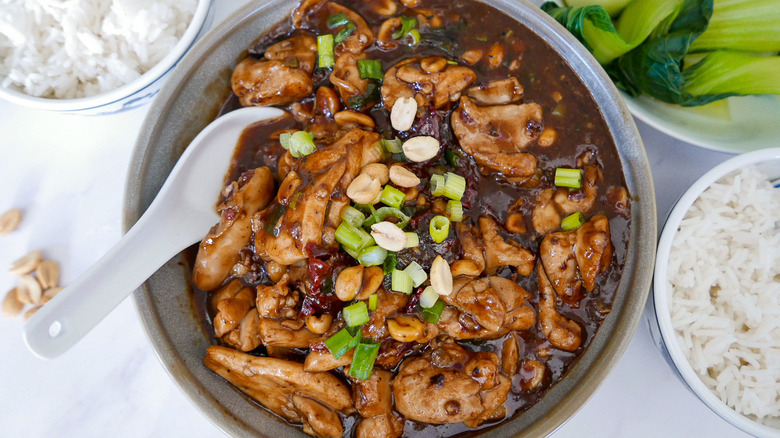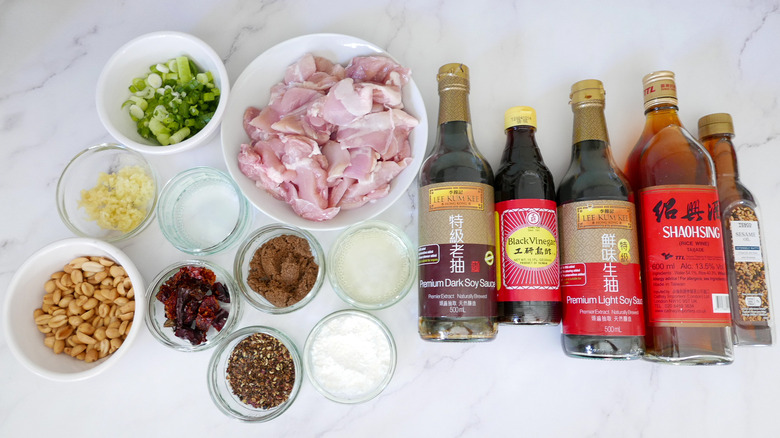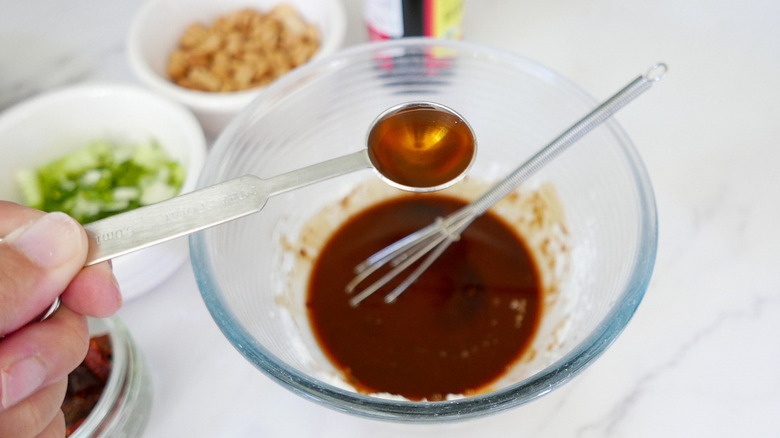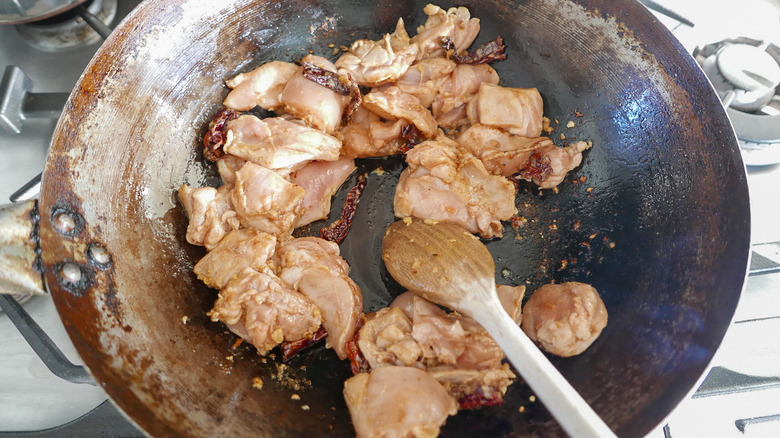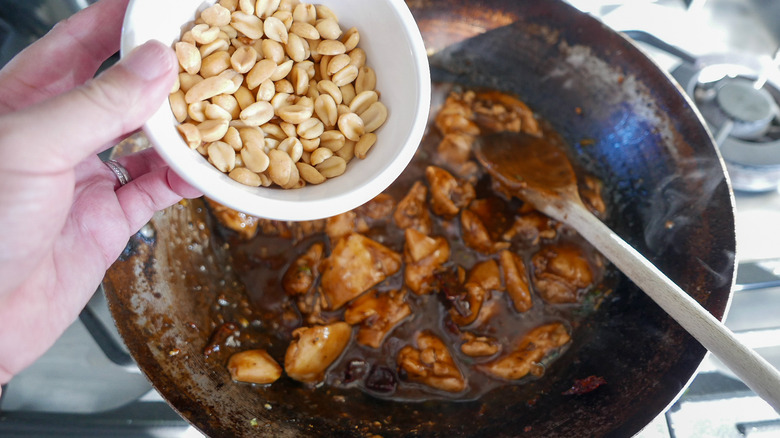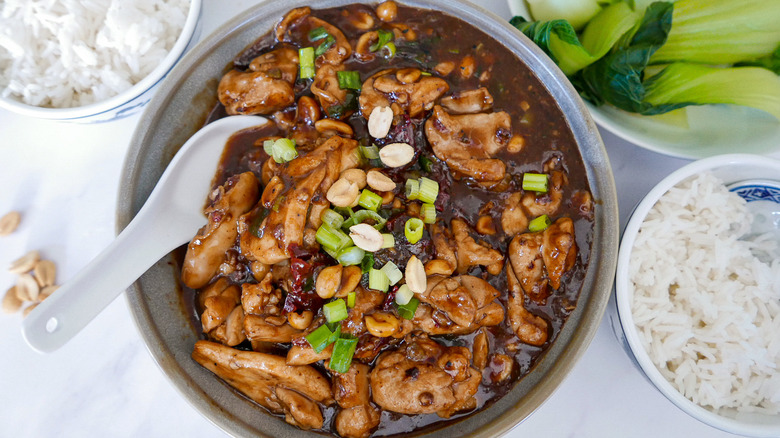Homemade Kung Pao Chicken Recipe
Getting Chinese takeout or delivery is undoubtedly one of the greater simple pleasures of city living. Nonetheless, consistency isn't always a given and it can be disappointing to open up your much-awaited meal and discover a meager amount of protein drowning in sauce. Not to mention the various other pitfalls you might encounter. The obvious solution? Figure out how to make your favorite dishes at home.
Ting Dalton, Tasting Table recipe developer and food blogger at Cook Simply, is all for making her own versions of popular dishes. This kung pao chicken recipe is no exception, and she notes, "the homemade version is super easy — and better than takeout." If you've never tried this stellar menu item, Dalton explains that "[It] originates from the Sichuan province of China." She further describes that "it has a spicy, distinctive flavor combination of the Sichuan peppercorns and black Chinese vinegar." Basically, this recipe sets you up for an undeniably flavorful dinner that you'll want to have as leftovers too.
Gather the ingredients for this homemade kung pao chicken
If you don't usually cook Chinese food, you might have to buy some sauces for this dish, but thankfully they all have a long shelf-life. For the protein, Dalton opts for chicken thighs and cuts them into bite-sized pieces for easy serving.
Next, you'll need a bit of cornstarch to thicken the sauce. The other components are light and dark soy sauce (the flavors layer for added nuance), Chinese black vinegar, Shaoxing wine (or Chinese cooking wine), brown sugar, sesame oil, and water.
Dalton highlights that the "Special ingredient here is the Chinese black vinegar. It adds a very distinctive sweet and sour note." You might not guess but it's made with glutinous rice, which she explains, "has an intensity that adds an important layer of flavor to this dish." Search for it at Asian supermarkets or online, and if you really can't find any, Dalton says that balsamic vinegar will work in a pinch.
You'll stir fry the bulk of the dish in vegetable oil. Minced garlic, finely chopped ginger, and green onions infuse warm aromas, while dries chilis add a kick. Dalton warns to remove the seeds if you want a milder result. Don't forget the Sichuan peppercorns, which Dalton indicates as key to the overall taste. She notes, "Make sure to grind them down though so they're crushed." Finally the kung pao chicken is served with unsalted roasted peanuts for a crunchy texture.
Start by making the sauce and marinating the chicken
Before you start the marinade, make sure that you've cut the chicken thighs into bite-sized pieces. Dalton prefers to keep them a little bigger than the usual small cubes you'll find in takeout kung pao. Next, set out a bowl and pour in the light and dark soy sauce as well as the cornstarch. Give it a good whisk until the powder has properly dissolved, thickening the sauce. Then, pour in the Chinese black vinegar, Shaoxing wine, brown sugar, and sesame oil. Make sure all of the ingredients are properly combined.
Place your chicken in a medium bowl, add 2 tablespoons of the sauce, and mix it in until the pieces are covered. Leave the chicken to marinate for a minimum of 15 minutes so that it absorbs flavor. Meanwhile, add ⅓ of a cup of water to the sauce and set it aside.
Stir fry the aromatics, then add in the chicken
Once your chicken has sufficiently marinated, set a wok over high heat and pour in the vegetable oil. Toss in the minced garlic, ginger, and chilis — remember to skip the seeds if you aren't ready for the spice factor. Stir fry them for 30 seconds to allow the aromas to come out. Next, throw in the chicken and stir fry it for a few minutes while the pieces cook. Add the green onions and keep stir frying the contents for another 2 minutes.
Finish cooking the chicken and toss in the peanuts
At this point, pour in the reserved sauce and the crushed Sichuan peppers. Reduce the heat to a simmer and continuously stir everything as the sauce thickens for a couple of minutes. When the sauce reaches the desired consistency and the chicken is cooked, throw in the roasted peanuts and stir them in until properly coated.
Serve this tasty dish with rice and vegetables
Dalton recommends serving your kung pao chicken with simple white rice and a side of green vegetables such as bok choy. For an extra touch of green, sprinkle some fresh chopped green onions to garnish the dish.
Store leftovers in the refrigerator for up to three days, or make your future self happy by freezing it for up to three months.
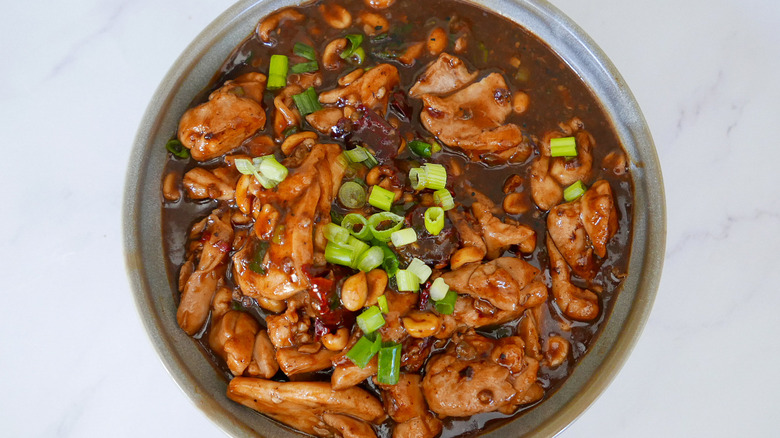
- 1 tablespoon light soy sauce
- 2 tablespoons dark soy sauce
- 2 teaspoons cornstarch
- 2 tablespoons Chinese black vinegar
- 1 tablespoon Shaoxing wine (or Chinese cooking wine)
- 2 tablespoons brown sugar
- 1 teaspoon sesame oil
- 1 pound chicken thighs, cut into bite-sized pieces
- ⅓ cup water
- 2 tablespoons vegetable oil
- 3 garlic cloves, minced
- 6 dried chilis, cut into pieces (discard seeds to reduce spiciness)
- 1 teaspoon ginger, finely chopped
- 3 green onions, finely chopped
- 1 tablespoon Sichuan peppercorns, crushed
- ¾ cup unsalted roasted peanuts
- rice, for serving
- In a bowl, mix together the light and dark soy sauce with the cornstarch to dissolve it.
- Add the Chinese black vinegar, Shaoxing wine, brown sugar, and sesame oil.
- Add 2 tablespoons of the sauce to a bowl with the chicken and marinate it for at least 15 minutes.
- Add the water to the remainder of the sauce and set it aside.
- Heat the vegetable oil in the wok over high heat.
- Add the garlic, chilis, and ginger and cook for 30 seconds until the aromas are released.
- Add the chicken to the wok and stir fry for a few minutes until it begins to cook, then toss in the green onions.
- Stir fry everything for another 2 minutes, then add in the sauce and Sichuan pepper.
- Bring the contents to a simmer, stirring constantly as the sauce thickens.
- Just before serving, stir in the peanuts.
- Serve the chicken immediately with rice.
| Calories per Serving | 525 |
| Total Fat | 40.6 g |
| Saturated Fat | 7.5 g |
| Trans Fat | 0.2 g |
| Cholesterol | 111.1 mg |
| Total Carbohydrates | 14.3 g |
| Dietary Fiber | 3.4 g |
| Total Sugars | 6.4 g |
| Sodium | 669.7 mg |
| Protein | 27.4 g |
